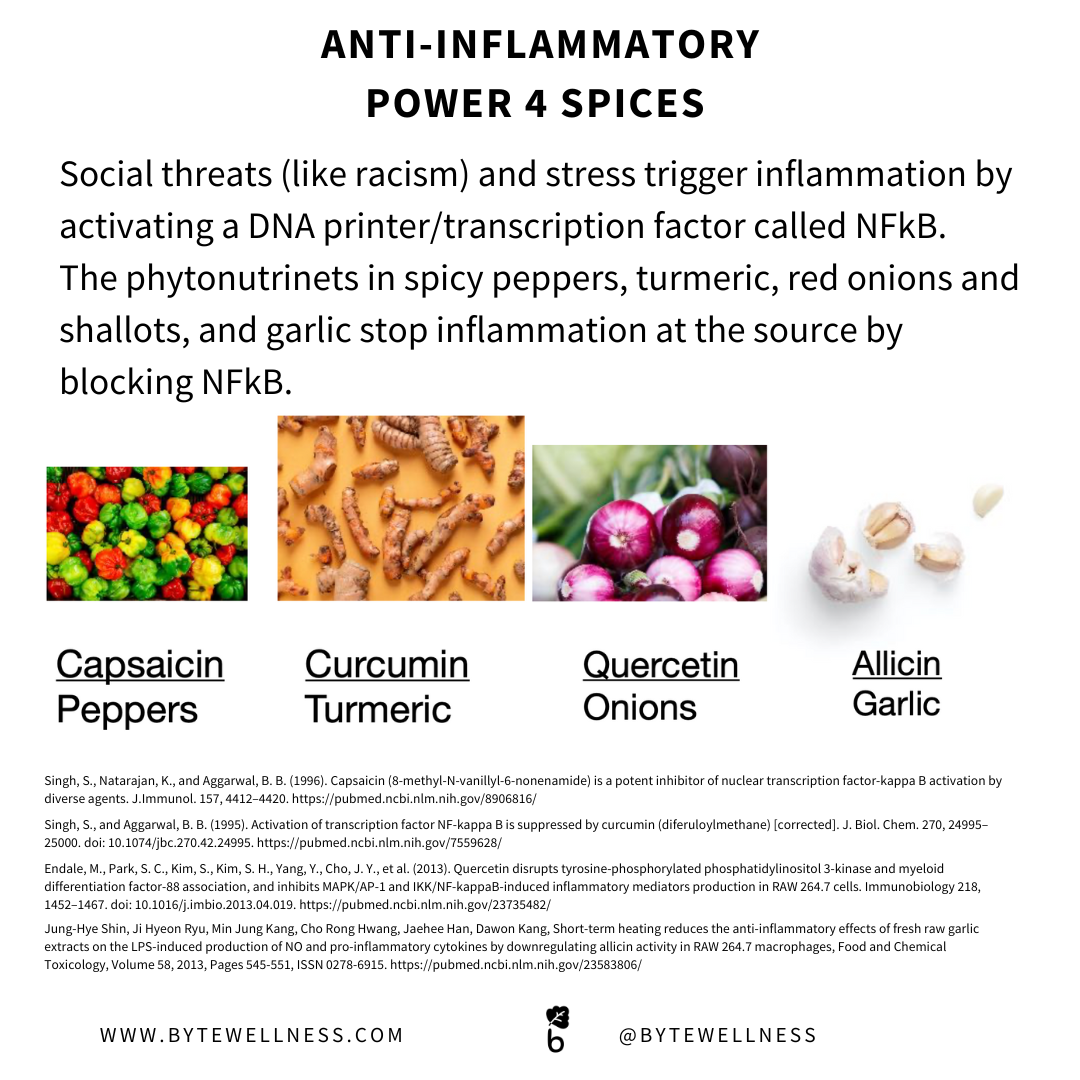Spice For Life [Self-Love Letter]
Hi Byte Wellness Fam,
How are you feeling?
I feel a sense of community, like I'm getting a big warm hug. It makes sense, because our community is growing! You all have done a great job of referring friends and loved ones. Then, they bring their good energy to our text thread and workshops, and everybody wins.
Check out the recording of this week’s #PhyteWellWednesday Workshop. If you didn’t get an invite to the workshop, send TEXT to 1(866)717-1919 to join the text thread and get weekly invites sent to your phone. You can also use that hook to help friends and family join.
#PhyteWell QUIZ :
Which plant magic chemical (phytonutrient) blocks inflammation in our bodies & is found in garlic and onions?
A) Curcumin
B) Capsaicin
C) Allicin
D) Quercetin
Answer: C!
Allicin is a plant magic compound- a phytonutrient- blocks inflammation & boosts health! It’s found in the plants of the allium family. Onions, shallots and garlic are in the allium family, so they are all rich sources of allicin!
Keep reading below to see how allicin blocks inflammation at its start.
*Remember to follow the 10-minute rule to make sure you get the full benefit of allicin: Cut or smash garlic and onions at least 10 minutes before you expose them to heat. Heating garlic and onions too soon will destroy the enzymes that create allicin after cutting.
As powerful as allicin is at counteracting inflammation and cutting our disease risks, it isn’t the only plant magic compound (phytonutrient) out there- far from it! Every plant has multiple plant magic compounds. Many of them have, at least, some anti-inflammatory action.
Remember that we need as much anti-inflammatory power as we can get throughout the day because we have an ongoing inflammatory risk factor, thanks to our exposure to racism, sexism, and other isms.
THESE 4 SPICES (AND THE PLANT MAGIC THEY CONTAIN) CAN BE ADDED TO ALMOST ANY SAVORY LUNCH OR DINNER MEAL FOR AN EXTRA RACISM-FIGHTING KICK.
Peppers
Turmeric
Red Onions/Shallots
Garlic
Check the workshop recording above to see how these spices fight inflammation.
Spice Is Nice
Peppers Are Anti-inflammatory
1) Peppers- (the hotter the pepper, the more capsaicin it has) - Habaneros have the highest content.
Capsaicin is the “heat” in spicy peppers. It puts a stranglehold on the main source of inflammation- the transcription factor (NFkB) that prints the genes for the cells and chemicals that contribute to inflammation.
Also, animal studies suggest that capsaicin is one of the few nutrients that can cross the blood-brain barrier. So, researchers are studying capsaicin for possible Alzheimer’s prevention and treatment. It is possible to eat too much pepper, which can paradoxically increase inflammation in our GI tract. When peppers feel too hot, we know we’ve reached our limit.
Turmeric Is Anti-Inflammatory
2) Turmeric- This orange root makes an appearance in South Asian cuisine and golden milk, but you really can add it to any dish (even dessert!)
Curcumin works the way that capsaicin does.
Red Onions are Anti-Inflammatory
3) Shallots and Red Onions- These two types of onions deliver some of the biggest doses of quercetin in our diet. Remember to cook onions on low-heat (no frying), to preserve as much quercetin during prep
According to studies in humans with blocked heart vessels, Quercetin cuts inflammation in a similar way to capsaicin and curcumin by handcuffing the inflammation printer NFkB.
Garlic is Anti-Inflammatory
4) Garlic- Garlic (and onions) are the main source of allicin in our diets. Just like quercetin and onions, garlic should be cooked at low temperatures or even eaten raw to get the highest amount of allicin.
Another note on prep: allicin doesn’t exist in whole garlic and onions. The enzymatic cascade that creates allicin only begins AFTER the food is cut or mashed. That process takes about 10 minutes to finish, and heat will ruin it. So, cut your onions or garlic and wait at least 10 minutes before heating, otherwise, you miss out on all that goodness!
Allicin technically isn’t a “polyphenol” like the 3 other chemicals. But, it’s a powerful anti-inflammatory and anti-oxidant compound, nonetheless. Allicin handicaps NFkB to cut inflammation at the source (like capsaicin and curcumin). Its sulfur compounds also minimize oxidative and reactive nitrogen waste.
More Healing Where That Came From
These 4 spices are just a sample of the healing that plants can bring into our lives. They’re a reminder of how powerful plants can be and how important it is that we eat ENOUGH of them.
We need anti-inflammatory support to counteract the ongoing risk of chronic inflammation triggered by the ISMS and other risk factors. So, it’s clear that plant healing isn’t an optional benefit, like a cherry on top of the ice cream sundae. Plant healing is the whole sundae! And the glass, too!
Most of the plant magic chemicals that we can’t get from animal products aren’t designated essential nutrients (although, like omega 3s and omega 6s are). Still, plant magic is very much ESSENTIAL to maintaining a healthy balance between the harm and healing in our body.
When we look at it that way, piling our plates high with veggies, fruit, whole grains and non-salt spices doesn’t require us to buy into a specific diet (vegan, vegetarian, etc). Although, it’s okay to do that, too.
Instead, the first step to getting more healing from plants is to believe that we’re worthy of healing! It’s on us to love us. It’s on us to protect us. If we don’t do it who will? Let’s get to it!
Do you believe you’re worthy of self-love and self-protection? I mean, do you really believe it? If you do, then eating more doesn't have to be daunting. You know you’re worth the effort of figuring out what types of plants you like- how to prepare them, where to find them, etc. Do you think you're prepared for that type of transformation? Why?
Happy Healthy Living,
Dr. Wuse

